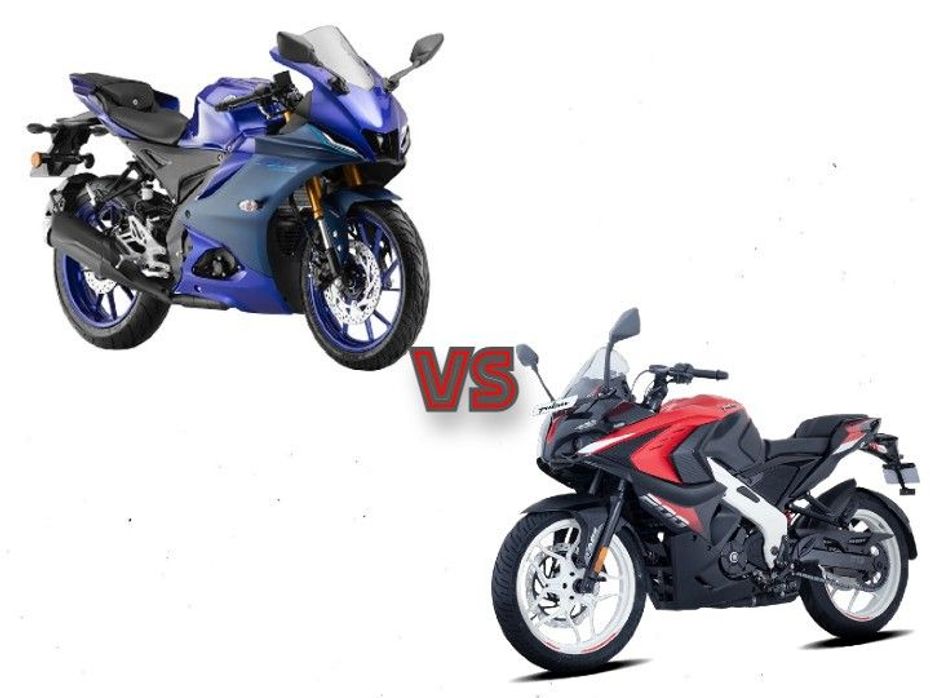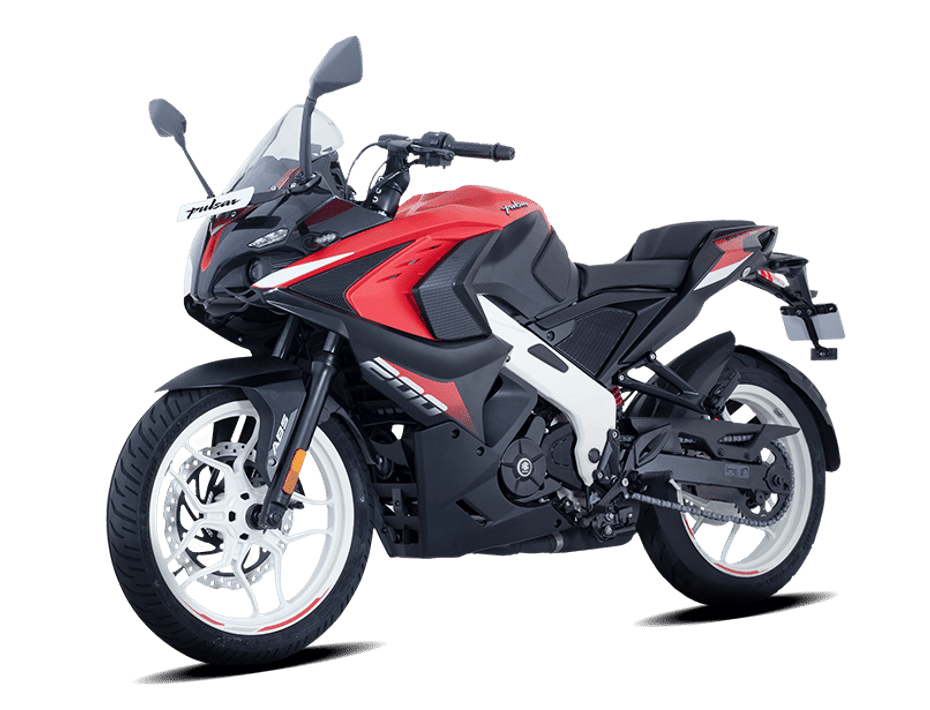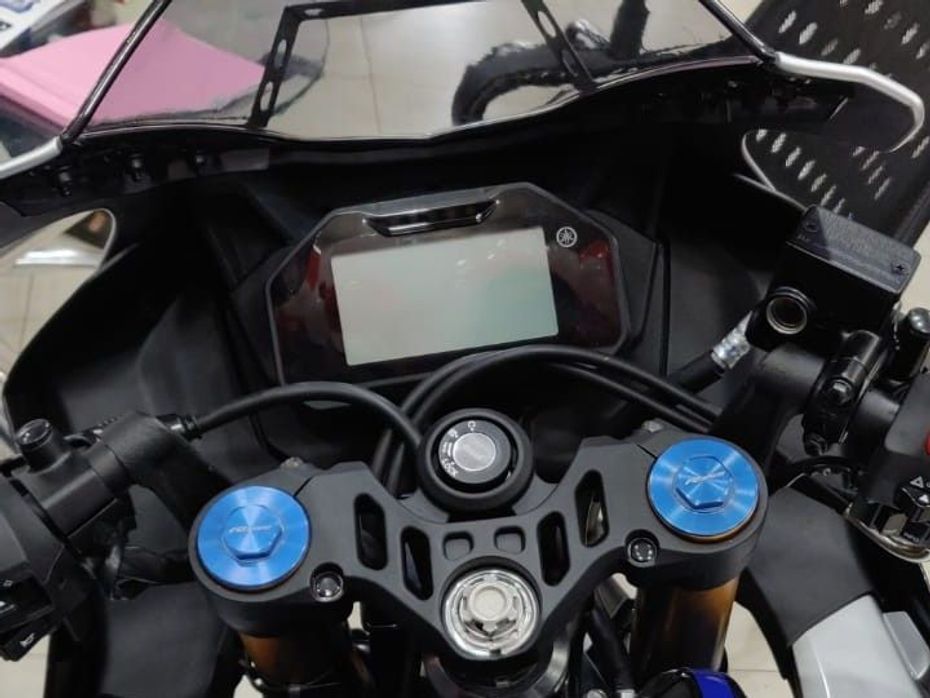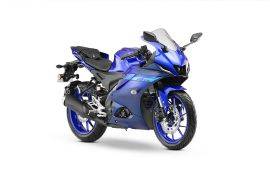
Yamaha R15 Range Gets Dearer
- Apr 6, 2022
- Views : 13082


The Yamaha R15 introduced the idea of affordable supersports to Indian enthusiasts. Over the years, competition grew, yet the Japanese supersport continued building a stronger fanbase. Now, in its fourth-generation avatar, the Yamaha YZF-R15 is more expensive than the Bajaj Pulsar RS200. So, should you really pick a 155cc motorcycle when you could get a more powerful alternative at the same price? Let’s find out.
Engine
| Specifications | Yamaha R15 V4 | Bajaj Pulsar RS200 |
| Engine | 155cc, single-cylinder, liquid-cooled, 4-valve engine | 200cc, single-cylinder, liquid-cooled, 4-valve engine |
| Power | 18.4PS @ 10,000rpm | 24.5PS @ 9750rpm |
| Torque | 14.2Nm @ 7500rpm | 18.7Nm @ 8000rpm |
| Gearbox | 6-speed | 6-speed |
Both bikes use 4-valve, liquid-cooled engines, and thanks to the 45cc advantage, the Pulsar develops 6.1PS and 4.5Nm more. While Yamaha’s engine is smaller, it packs more equipment than the Bajaj. For starters, it gets variable valve actuation (VVA), meaning the low-end grunt doesn’t come at the cost of top-end performance. Furthermore, the 6-speed gearbox on the R15 is paired with a slip-assist clutch so that clutch action lighter and aggressive downshifts don’t throw you off-guard.
Underpinnings
| Specifications | Yamaha R15 V4 | Bajaj Pulsar RS200 |
| Frame | Deltabox | Perimeter |
| Front suspension | USD fork | Telescopic fork |
| Rear suspension | Link-type monoshock | Gas-charged monoshock |
| Front brake | 282mm disc | 300mm disc |
| Rear brake | 220mm disc | 230mm disc |
| Front tyre | 100/80-17 | 100/80-17 |
| Rear tyre | 140/70-R17 | 130/70-17 |
Yamaha has retained the fabled Deltabox (perimeter) frame. But the big news comes in the form of the USD fork, which is a first for an India-spec model. At the rear, it gets a link-type monoshock good at soaking minor undulations. On the other hand, the PulsarRS200 relies on a regular telescopic fork and a gas-charged monoshock. Though the latter is swingarm-mounted, the gas canister aids damping, which should result in a smoother ride.

The braking setup on both bikes is similar -- discs at both ends paired with axial calipers at the front. Dual-channel ABS comes as standard on both. However, the RS200 gets bigger discs considering the more performance generated and its extra heft.
Like the previous-generation model, Yamaha chose to equip the V4 with a bias-ply front tyre and a radial rear tyre, a set up that has its limitations. Bias-ply tyres tend to heat more and wear out faster than radial units, and even have slightly poor traction levels. The Bajaj Pulsar RS200 not only has bias-ply tyres at both ends but also a slimmer rear tyre, limiting cornering angle.
Dimensions
| Specifications | Yamaha R15 V4 | Bajaj Pulsar RS200 |
| Wheelbase | 1,325mm | 1,345mm |
| Ground clearance | 170mm | 157mm |
| Fuel tank capacity | 11-litres | 13-litres |
| Seat height | 815mm | - |
| Kerb weight | 142kg | 166kg |
If it's cornering we are talking about, the R15 V4 takes the win. In addition to being lighter by 24kg, the taut 1325mm wheelbase makes the bike super agile in the corners. Also, the 815mm seat height makes the bike manageable for riders of all sizes.

The Bajaj Pulsar is slightly different, maintaining that balance between everyday useability and outright sportiness. That said, the 157mm ground clearance might be problematic when encountering big speed bumps on your commutes.
Features
| Yamaha R15 V4 | Bajaj Pulsar RS200 | |
| Digital Console | Yes | Yes |
| Display modes | Yes | No |
| Navigation | No | No |
| Traction Control | Yes | No |
| Quickshifter | Yes | No |
| Navigation | Yes | No |
| Caller ID/SMS, Email alert | Yes | No |
| Last Parking Location | Yes | No |
| Gear-position indicator | Yes | No |
| Real-time mileage | Yes | No |
| Average fuel efficiency | Yes | No |
| Distance-to-empty | Yes | No |
| LED headlamp | Yes | No |
Yamaha has gone all guns blazing with the YZF-R15 V4, introducing segment-first features like a quickshifter and traction control. Also, thanks to the new Bluetooth-enabled instrument console, the bike gets improved functionality. On the other hand, the Pulsar comes with a part-digital instrument console with limited functionality.

Price And Verdict
| Yamaha R15 V4 | Bajaj Pulsar RS200 | |
| R15 Metallic Red | Rs 1,67,800 | Rs 1,63,168 |
| R15 Dark Knight | Rs 1,68,800 | |
| R15 Racing Blue | Rs 1,72,800 | |
| R15M | Rs 1,77,800 | |
| R15 Monster Energy | Rs 1,79,800 | |
Now doesn’t the Yamaha YZF-R15 justify its price tag? Sure, it is more expensive than the Bajaj Pulsar RS200, but for that, Yamaha is offering better hardware and a host of features, including segment-first additions. When compared to the R15, the Pulsar RS200 certainly feels dated and is best suited for someone looking for a bike to commute and go on occasional weekend jaunts.


Yamaha R15 Range Gets Dearer

Yamaha R15 V4 Gets Dearer For The First Time

2021 Yamaha R15 V4 First Ride: Eternally Young?

Yamaha R15 V4 vs Other Faired Bikes - Specifications Compared

Sportlife Stepping Stones: KTM RC200 vs Yamaha R15M

The Yamaha R15 Is Faster Than This 250cc Chinese Bike!

How Different Is The BS6 Yamaha R15 V3 From The BS4 Iteration?

Yamaha YZF-R15 v3.0 vs KTM 125 Duke & Battle of Sporty Beginner Bikes

Yamaha R15 V3.0 vs Aprilia RS 150 vs Bajaj Pulsar RS200: Spec...

Here’s What TVS Has Changed On The New Apache RR 310
 Yamaha R15S
Yamaha R15S
 TVS Apache RR 310
TVS Apache RR 310
 Suzuki Gixxer 250
Suzuki Gixxer 250
 Yamaha MT 15 V2.0
Yamaha MT 15 V2.0
 Suzuki Gixxer SF
Suzuki Gixxer SF
India's largest automotive community
 Yamaha MT 15
Rs. 1.69 Lakh
Yamaha MT 15
Rs. 1.69 Lakh
 Yamaha yzf r15 v3
Rs. 1.66 Lakh
Yamaha yzf r15 v3
Rs. 1.66 Lakh
 yamaha fz s fi version 3
Rs. 1.22 Lakh
yamaha fz s fi version 3
Rs. 1.22 Lakh
 Yamaha fzs fi v4
Rs. 1.30 Lakh
Yamaha fzs fi v4
Rs. 1.30 Lakh
 Yamaha FZ-FI V3
Rs. 1.17 Lakh
Yamaha FZ-FI V3
Rs. 1.17 Lakh
 Yamaha Ray ZR 125
Rs. 92,880
Yamaha Ray ZR 125
Rs. 92,880
 Yamaha Aerox 155
Rs. 1.49 Lakh
Yamaha Aerox 155
Rs. 1.49 Lakh
 Yamaha Fascino 125
Rs. 92,680
Yamaha Fascino 125
Rs. 92,680